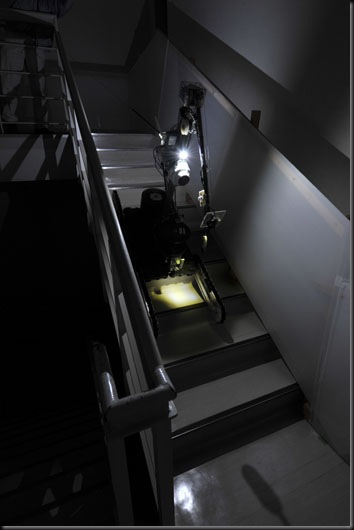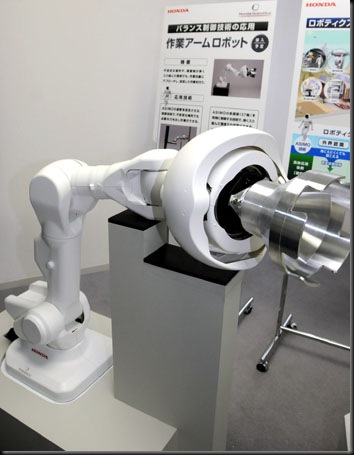NUCLEAR AWAKENING By HIROKO NAKATA
Staff writer -- Last of five parts
After the March 11 tsunami slammed into the Fukushima No. 1 nuclear plant and wrecked three reactors, many people expected the nation's cutting-edge robotic technologies to come to the rescue.
 |
| Slinky move: Quince moves down stairs at Chiba Institute of Technology in June. CHIBA INSTITUTE OF TECHNOLOGY |
In the early stages of the nuclear crisis, many people actually sent messages to the Asimo Twitter account run by Honda Motor Co., asking why the robot wasn't participating in recovery efforts led by the government and plant operator Tokyo Electric Power Co.
The reply they received, however, said only that "Asimo is still in development, but Honda hopes it will be a helper to people someday, maybe in (similar) dangerous situations like this."
After 15-meter tsunami engulfed the plant in March, sparking a chain of events that would result in reactors 1, 2 and 3 suffering meltdowns and emitting huge quantities of radioactive materials, the sky-high radiation levels in the reactor buildings prevented workers from going anywhere near them. This lead many people to assume that Japan's robotic prowess would play a crucial role in reining in the crisis.
As it turned out, however, the first robots to enter the buildings and provide the first glimpses inside were American. The two Packbot robots, developed by Massachusetts-based technology firm iRobot Corp. and used by the U.S. military, proved invaluable during early efforts to ascertain the full extent of the wreckage inside the units, which suffered huge structural damage as a result of hydrogen explosions.
One Japanese robot was eventually used at the Fukushima No. 1 plant, a caterpillar-shaped rescue robot called Quince, developed by scientists at Chiba Institute of Technology and other universities. After the scientists reinforced it with new radiation protection features, the robot was sent to Fukushima and carried out six missions at the complex between June 24 and Oct. 20.
 |
| Handy: Honda Motor Co. unveils a prototype remote-controlled arm at its research center in Saitama Prefecture on Nov. 8. The arm will be used at the Fukushima No. 1 nuclear plant. SATOKO KAWASAKI PHOTO |
The domestic robot industry, in fact, had stopped working on ways to shield robots from extreme radiation around 10 years before the Fukushima crisis, and manufacturers and institutes were caught completely off guard, experts said.
The nature and focus of Japanese robotic technologies are in sharp contrast to battle-hardened U.S. military robots such as Packbots, which have been deployed countless times on battlefields in Iraq and Afghanistan, and also used to detect radioactive compounds at sites too hazardous for humans to access.
Most domestic companies have focused on developing humanoid robots that can assist people in need of nursing and other forms of care, and improve their quality of life. Domestic rescue robots, meanwhile, are mainly built to operate at sites of natural disasters, or at sites of chemical and biological attacks, according to robotics scientists.
Some experts claim the government was previously unwilling to finance projects to develop robots that could be used during a nuclear accident, fearing such a move might imply that a nuclear disaster was possible and cause the public to question the safety of atomic plants.
"The government thought that a nuclear accident on this scale, resulting in such a massive release of radiation that humans can't get close to the reactor buildings, was almost impossible," said Eiji Koyanagi, vice director at the Future Robotics Technology Center at Chiba Institute of Technology.
That myth was shattered by the Great East Japan Earthquake.
Meanwhile, demand for brand new technologies and devices surged amid the nuclear crisis and manufacturers responded by developing a variety of products. New devices that afford nuclear plant workers better protection against radiation exposure and machines that check food products for radioactive contamination were among the various products that hit the market last year.
Among new technologies, Honda is currently developing a robotic arm that will operate at disaster sites and other places deemed toohazardous for rescue workers. When completed, the robotic arm would be able to grab, open and close pipe valves at power plants during a nuclear accident, a function Tepco specially requested.
But the project, which is using technologies developed to build Asimo, is still at the pilot testing stage.
"When I heard that foreign robots were the first to work at the site of the Fukushima No. 1 plant accident, I felt deep regret," said Satoshi Shigemi, chief engineer for the Asimo. "So I started to think about what I could do to assist (recovery efforts)."
Shigemi said the Fukushima crisis has shown that one of the primary uses of robots is at disaster sites that are inaccessible to humans, adding that Honda, whose development of robots has been aimed at supporting people in need of care, must broaden the scope of its robotics research and development.
As for new devices, Fuji Electric Co. manufactured a radiation detector capable of checking 200 cardboard boxes worth of food for contamination in about an hour, far quicker than existing detectors.
The ¥4.3 million device can detect radioactive iodine and cesium in rice, beef and vegetables, and food wholesalers and local governments have purchased about 50 of the devices in the last four months, Fuji Electric said.
The company started designing the detector after some food products were found to be contaminated with excessive levels of radioactive cesium, sparking food safety concerns and demands from consumers that all foods be checked before they reach the market.
The device is both faster and easier to use for checking food products than existing radiation detectors, which require inspectors to cut out part of the food and thinly slice it for testing. The process is so time-consuming that inspectors usually only test samples from a few products, instead of a whole batch.
Manufacturers such as Fuji Electric and robot developers like Honda launched these projects hoping to tap the demand for new products created by the nuclear crisis.
But in terms of existing robotic technologies, the U.S.-built Packbots were the obvious choice to explore the No. 1 plant's shattered, radiation-saturated reactor units. About 3,500 Packbots have been manufactured in total, and they have been used hundreds, if not thousands, of times in dangerous or hazardous sites. They also come with excellent instruction manuals, said Koyanagi of Chiba Institute of Technology.
When the institute decided to send its own robot, Quince, to the devastated Fukushima plant, various factors conspired to delay its dispatch.
"Packbot was ready like cup noodles. In the case of Quince, we had to (go back to the basics and) start kneading flour and water to make dough," said Koyanagi, who was in charge of the institute's project team.
The first task the team's scientists faced was devising a way to shield the robot from extreme radiation. The team eventually decided to use a 13-mm-thick lead cover to protect Quince's controller, although this added 21 kg to the robot's weight, raising it to around 47 kg in total.
Next, project members had to come up with a method for Tepco engineers to operate Quince remotely from locations far from the crippled reactors, as the robot's existing wireless system would have malfunctioned inside the fortified reactor buildings.
The team ultimately decided to use a 450-meter cable to link Quince and the engineers operating it, but this ended up creating new problems. The cable can easily snap when the robot is moving among or on top of debris, and it also has to be retracted automatically to prevent Quince from trampling over and potentially damaging it.
Once the robot was ready, Koyanagi then had to spend an additional three weeks training Tepco workers how to operate the robot and replace its batteries and cable.
When Quince was finally sent to the Fukushima No. 1 power station, its first mission was to gauge radioactivity levels in contaminated water that had flooded parts of the reactor buildings, and to photograph debris at the complex.
Despite its tardy deployment, Quince proved to be better than the Packbots in certain aspects, Koyanagi said: The quality of the photos it takes is superior, it is better at climbing up and down stairs, and its manual is in Japanese.
Quince is also easy to reprogram whenever Tepco workers submit new specifications, as it does not contain confidential defense technology — unlike its U.S. rival.
Unfortunately, Quince proved to be less adept than the Packbots at exploring the wrecked units, and has been stuck inside the No. 2 reactor building since its cable snapped in October. Engineers have been unable to retrieve it, and a new Quince robot is scheduled to be sent to the plant later this month.
"If some people can enter the reactor 2 building after say, 1½ years, I want them to change the batteries in (the currently stuck robot) and switch Quince on to test its durability in its highly irradiated surroundings, so that future projects can use the data," Koyanagi said.
Japan has never pursued a long-term, sustainable and continuous program to develop robots for use at nuclear plants during a major crisis.
In 1999, two workers died and more than 600 people were exposed to radioactive materials after a criticality accident at a nuclear fuel processing plant run by JCO Co. in Ibaraki Prefecture.
In light of the accident, the government allocated ¥3 billion for the development of robotic technologies in the 1999 fiscal year, through a supplementary budget.
Of this total, ¥700 million was allocated to each of three major domestic manufacturers of industrial machinery — Mitsubishi Heavy Industries Ltd., Toshiba Corp. and Hitachi Ltd. Between them, the three firms created several robots for use during nuclear accidents.
Another ¥600 million went to Nissho Iwai Corp., a major trading company now known as Sojitz Corp., which used the funds to buy a French-built robot.
But there was no opportunity to properly test and monitor the robots in the field — in other words, during a nuclear accident — and the technologies created while building them were not handed down to later projects, according to Koyanagi.
One of the robots is on display at Tohoku University in Sendai, while the robot Hitachi developed is exhibited at the Sendai Science Museum. The whereabouts of the other robots is unknown.
"Data on robots' durability under high-level radiation has not been updated in 10 years. But during this period, the capacity of semiconductors grew exponentially," Koyanagi said, stressing the need for sustainable robotic research and development to enable Japan to catch up with current global technologies.
But after the twin disasters and the Fukushima nuclear crisis, the government at long last began to examine ways to revive the domestic robotics industry.
It also allocated about ¥1 billion to a project that aims to develop robots that can operate in high radiation surroundings, via its third supplementary budget for fiscal 2011.
On Dec. 21, nuclear crisis minister Goshi Hosono and trade minister Yukio Edano instructed Tepco, as well as the Agency for Natural Resources and Energy and the Nuclear and Industrial Safety Agency, both under the trade ministry, to accelerate work to develop remotely controlled robots. The two ministers specifically called for robots capable of withstanding huge doses of radiation and able to remove melted nuclear fuel rods at the No. 1 plant to be created as soon as possible.
Chiba Institute of Technology's Koyanagi said the central government also needs to create a training center where rescue experts, such as members of hyper-rescue teams and the Self-Defense Forces, can work with scientists at universities to ensure the nation continues to develop new robot rescue technologies.
Nevertheless, it remains unclear if Japan can build on the robotic technologies developed amid the Fukushima nuclear accident and undertake a sustained long-term initiative to catch up with — and then hopefully advance — current technologies.
Read more:
http://www.japantimes.co.jp/text/nn20120106f1.html
